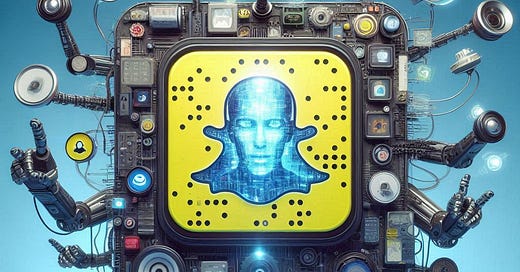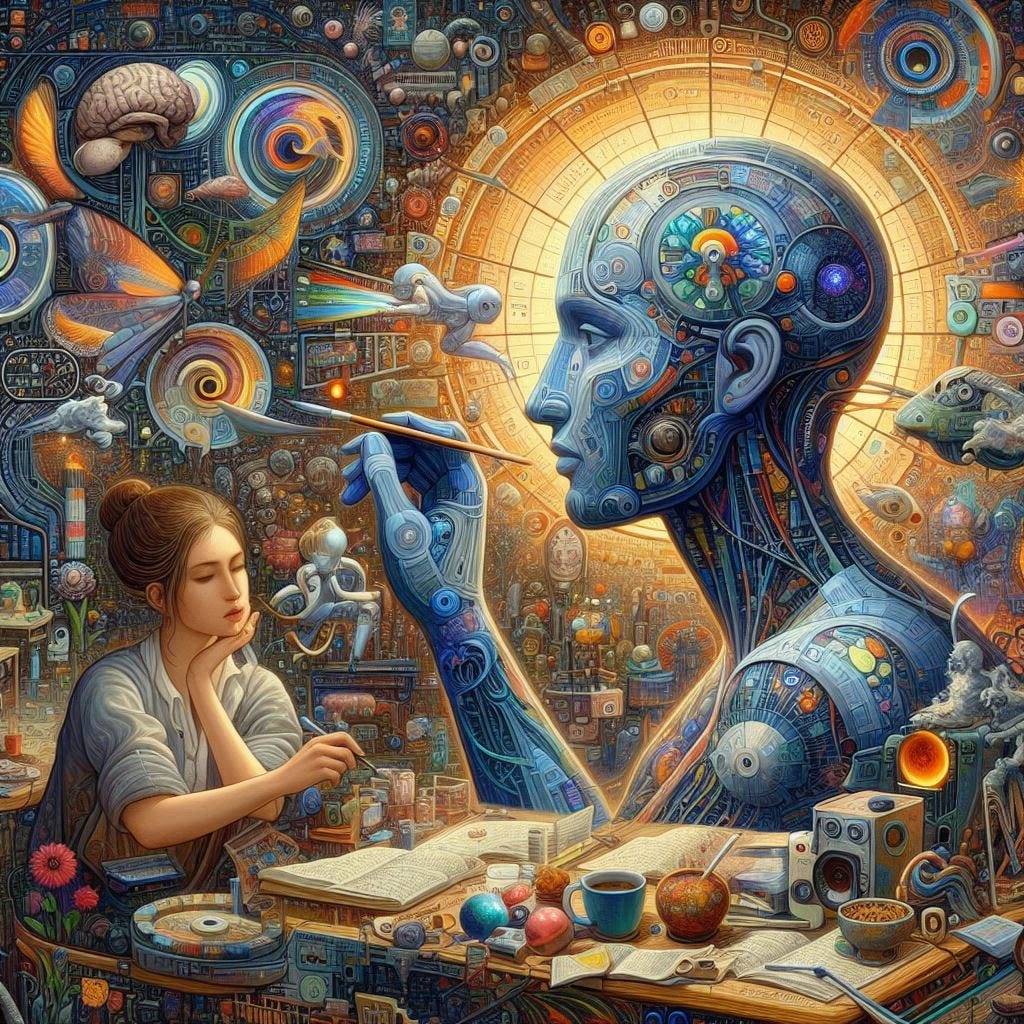#5: AI in Social Media - Snapchat AI; AI in Food Industry - McDonald's DriveThrough; AI in Healthcare - AI is everywhere!
And how AI is Improving Developer's Productivity!
Transforming Social Media with AI: Snapchat’s AI Revolution.
Snapchat, social media which started with the concept of users sending messages that self-destruct after a few moments is now heading towards the future with powerful artificial intelligence (AI) technology.
The emergence of Lens Studio 2, touted to be a milestone in augmented reality (AR), helps in changing the procedure from coding into simple alerting with the use of AI. The event filter has been made very easy to use with the help of simple keyword phrases where the AI engine will create the filter as visualised by the user. As to options – users can turn their pets into magnificent creatures, vary faces with the help of marvellous paintings, and much more.
Meet Snap Sensei, your AI companion within the Snapchat territory – the network. It uses snap codes to identify what type of filters you like to use and then proposes new filters for use in the snaps. If you are in search of awesome filters to accompany your selfies or searching for AR effects that fit your hangout vibes, Snap Sensei will help you make the best of your night. It can also assist you in finding a specific lens from the vast list of lenses that aligns with your chosen theme.
Their AI is constantly learning to identify and remove inappropriate content, creating a safer online environment for everyone. They've even developed tools to combat cyberbullying, with options to identify potential incidents and offer helpful resources to those in need. The innovative "Snap Guardian" AR filter utilises facial recognition technology to blur unwanted faces in your snaps, giving you ultimate control over what you share.
Such developments can be considered only as the first steps of a long and interesting way for Snapchat. Through the integration of AI and AR, the platform has the potential to transform social media, human interaction, and communication. It will be rather interesting to observe what new branches of technology will be developed in the process at Snapchat. Follow updates for more details.
McDonald’s AI drive-through
We are at the edge of a technological storm in the fast-food industries. McDonalds didn’t waste the opportunity! It seems to have set the direction toward using artificial intelligence at drive-through services. The first key innovation to emerge from McDonald’s in this regard was the Automated Order Taker which the company adopted in its operation after developing the innovation with IBM’s assistance.
Their AI was built to efficiently manage the ordering tasks and included NL and machine learning algorithms to facilitate a better understanding of customer queries and orders.
Although the technology was promising it was not always very easy to use - inability to comprehend accents, interpret order details, and failure to perform well during rush hours. It provoked discussions on social media regarding hearsay of AI making bizarre menu suggestions and hopelessly confusing order tickets. Such hitches negatively impacted the customer experience and exposed the constraints of contemporary AI technology. For now, it has put it on hold, however, it doesn’t mean that it has done away with AI altogether. The company recognises the availability of potential voice-ordering solutions and aims to search for other solutions for the remaining part of 2024.
The cost of implementing and maintaining the AI system across many restaurants simply wasn't justifiable when weighed against the benefits. While the dream of a seamless, AI-powered drive-thru remains, for now, McDonald's has opted to focus on more cost-effective solutions.
The McDonald’s example can be considered as practically significant for the development of the fast-food sector. This underlines the importance of developing a new generation of AI systems with high, not only precision but also versatility and practicality. Pushing forward into the future, an advancement in A. I. Technology might lead to the development of a more efficient drive-thru and less of a headache for the consumers.
Anthropic’s Claude 3.5 Sonnet LLM
Anthropic, which specialises in ethical and responsible AI solutions, has unveiled its newest model called Claude 3. 5 Sonnet1. Originally, it is claimed to be two times faster in request processing compared to Claude 3 Opus 2. This enhancement is believed to render it optimal for handling multi-tier tasks demanding fast and fine-tuned outputs.
Alongside Claude 3. 5 Sonnet, Artifacts is a new feature with the ability of AI to engage in a conversation in real-time. This forms a creative environment where text and multimedia documents as well as coded and constructed artefacts can be viewed, edited, and extended within the essence of the chat interface3. It’s a game-changer for collaborative environments and could revolutionise how teams work together.
The birth of Claude 3.5 can be seen as a breakthrough toward a better understanding of AI and its possibilities in the functioning of various endeavours. The trend that we are seeing is only set to continue as technology companies around the world turn up the heat in the race for AI development. Current developments by various organisations including Anthropic are great for setting the bar higher. Click here for more updates if you are interested in the future direction from Anthropic.
AI to the Rescue: How Version Control is Getting Smarter for Developers
Imagine a way where your merge conflicts resolve themselves and finding that particular snippet of code is easy. Thanks to artificial intelligence (AI), that has become a possibility. Version control systems (VCS) are getting major upgrades, and developers are levelling up their workflows.
Boosting Productivity
AI can analyse your code for potential bugs, recommend improvements and save valuable time. Feeling stuck on a merge conflict? Don’t worry because AI can predict and even resolve these conflicts automatically which keeps your workflow smooth.
Lesser Errors, More Efficiency
AI can find issues before they occur by analysing code for vulnerabilities and best practices. This enhances your overall code quality and also prevents future headaches. It can also predict the impact of changes between one set of codes to another enabling you to realise any likely mistakes long before they start disturbing your main projects.
Finding your code
Do you always have trouble finding that specific block of code hidden within your project? With AI-powered search features capable of interpreting natural language questions and delivering results in a flash. This makes it easier than ever to navigate large code bases and reuse existing codebases.
Keeping Up with the Times
Though important for any project, documentation may be quite difficult to try to keep up with. AI helps by automatically generating those documents whenever your code changes. This makes sure that your documentation is always up to date and accurate.
Choosing Your VCS Tool
Picking out the best version control system depends on your specific needs. Git is a good choice for projects that are large and complicated because of its speed and flexibility. Mercurial provides a simpler approach suitable for beginners or smaller groups. Subversion is a popular choice in enterprises since it has a simple interface.
Developers who adopt AI into version control systems work smarter and faster. AI is transforming the way developers collaborate and build amazing software, with improved code quality & streamlined workflows.
Unveiling artificial content with Google’s SynthID
Can you tell whether a poem is written by an AI? Can it explain complex information to you or make a funny video? But what if you are not sure if this content was created by a human being or a machine? That’s when Google’s SynthID comes will help!
The danger we face today is the increasing potential for misuse of AI tools. In response, SynthID is embedding secret watermarks directly into developed artificial intelligence content such as images and videos. The watermark cannot be seen by humans but can be detected by computers to determine whether what they are looking at is AI-produced.
SynthID is not a foolproof solution, but it is definitely a necessary step towards living with and interacting with AI content meaningfully. We could then judge how we trust and use that information by knowing if it was AI generated.
An important part of Google’s commitment to responsible AI development is the belief in making SynthID available to others. That is why they plan on open-sourcing the text watermarking technology so that AI developers can implement it within their models. This inclusive method will help fight against misuse of AI and enable creators to earn the trust of their audience. Read more in-depth here.
AI in Health: Transforming Medical Diagnosis
Think of a world where doctors have an assistant who can pick up things in medical scans that are not seen that easy physically and therefore speed up diagnoses. Guess what - such a world is fast approaching! AI is quickly changing healthcare, making it faster, smarter, and more accurate.
Diagnosing diseases depended so much on the ability of doctors to interpret scans or data accurately. This process may take a lot of time and has room for human error and this is where AI comes in to the rescue. AI can identify abnormalities that might sometimes go unnoticed by even the most seasoned doctor. It goes through complex medical information in a better and quicker manner. This could be a game changer in early-stage detection of diseases such as cancer.
Hospitals and clinics are already experiencing the impact of AI. IBM Watson Health and Google’s DeepMind Health are among the leading firms. AI tools have made it possible for several facilities to report marked improvements in diagnosis precision as well as efficiency.
Moorfields Eye Hospital in London has recently joined hands with DeepMind to study eye scans using AI. This technology has shown remarkable proficiency in studying images from eye scans and showing high performance in diagnosing conditions like diabetic retinopathy. A number of patients may get quicker and more precise diagnoses.
The potential that artificial intelligence has in healthcare is just starting to be recognized. Researchers are developing AI’s ability to deal with a much wider range of diseases, and features which could incorporate seamlessly into existing healthcare systems. What if we had an AI system that predicted outbreaks of diseases or one that personalised treatment plans based on your genetic material? Something to think about.
AI is not meant as a substitute for doctors - instead - it compliments them. By providing faster and more accurate analysis, medical diagnostics with the use of AI has transformed medicine thereby enabling better-informed decisions by physicians, and earlier interventions, leading to improved patient outcomes ultimately. With the ongoing progress of AI technology, however, we can expect this number to increase drastically over time









